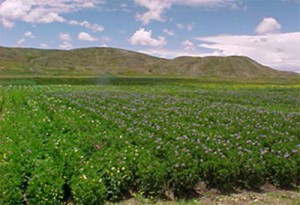 The Peruvian-Bolivian Altiplano is one of those regions in the world where generations of farmers have dealt with and successfully adapted to high climatic variability. Historically, through the sophisticated and rational use of local physical and biological resources, Altiplano farmers have always managed to ensure the safety of their food security, despite the odds against them.
The Peruvian-Bolivian Altiplano is one of those regions in the world where generations of farmers have dealt with and successfully adapted to high climatic variability. Historically, through the sophisticated and rational use of local physical and biological resources, Altiplano farmers have always managed to ensure the safety of their food security, despite the odds against them.
In the face of a rather fragile agriculture, affected by climate variability, people of the Altiplano developed an approach similar to the strategy of modern investors in the stock market, who diversify their investment portfolios to deal with the risk and volatility of speculative finances. Thus, the Andean families learned to invest natural, social and financial capital in a diversified portfolio of options to deal with uncertainties and climate risks.
A clear example of this strategy is shown by the way in which potatoes are still grown by traditional farmers. Potato is the staple crop of the farming household and the basis of food security for the local economy. The strategy for coping with climate variability involves the simultaneous planting of many varieties (variety mixtures) in the same cropping field during a growing season. These mixtures may total more than 40 to 50 different varieties and landraces and the composition of the mixture may vary in subsequent years, based on the yields obtained under the experienced weather conditions and the expected returns based on the forecasted weather for the following planting season.
The rationality behind the use of varietal mixtures, which is somewhat contrary to the common logic of using a single adapted and high performance variety, has been explained by the CIP scientists working with CCAFS – the CGIAR Research Program on Climate Change, Agriculture and Food Security – using potato growth simulation models. This analysis shows that early varieties with early tuber formation and fast tuber filling rates can produce a harvest when early frosts are intense, severely affecting the later varieties. These are able to produce higher yields, especially since they are more tolerant to late blight and intense frosts and droughts.
Additionally, mixtures also include some potato varieties tolerant to pests and diseases, of which the incidence and severity are also determined by meteorological conditions. Moreover, mixtures are also diverse in terms of cooking quality and end-use of the tubers. The net result of the use of potato mixtures is then a reduction of vulnerability and food insecurity in a society that has practiced subsistence agriculture in an environment of high climatic variability.
Women play key role in the Altiplano in the conservation of potato genetic resources
 Women in the Altiplano have played and still play a key role in the development and maintenance of this adaptive production strategy. They are actively involved in observing the performance of the different varieties in response to factors causing abiotic and biotic stresses and in the selection of the better-adapted varieties and landraces. Women also exchange knowledge, experiences and genetic material in the traditional fairs, enhancing and preserving traditional knowledge.
Women in the Altiplano have played and still play a key role in the development and maintenance of this adaptive production strategy. They are actively involved in observing the performance of the different varieties in response to factors causing abiotic and biotic stresses and in the selection of the better-adapted varieties and landraces. Women also exchange knowledge, experiences and genetic material in the traditional fairs, enhancing and preserving traditional knowledge.
Traditional societies such as that found in the Altiplano are rapidly integrating their agricultural practices to the modern input and output markets. However, the principles in which they had based their survival in the face of climate variability for thousands of years are still valid. For this reason, the experience in the Altiplano makes us realize the need to study systematically and in an unbiased manner the rationality of ancient practices and their applicability to the new situations created by climate change and the increased climate variability around the globe. Understanding this knowledge and the principles involved would help develop and strengthen new strategies to face climate change in different parts of the world. One lesson learned from these societies is the importance of biodiversity conservation.
Blog produced by CIP’s Production System and Environment Sub-Program
